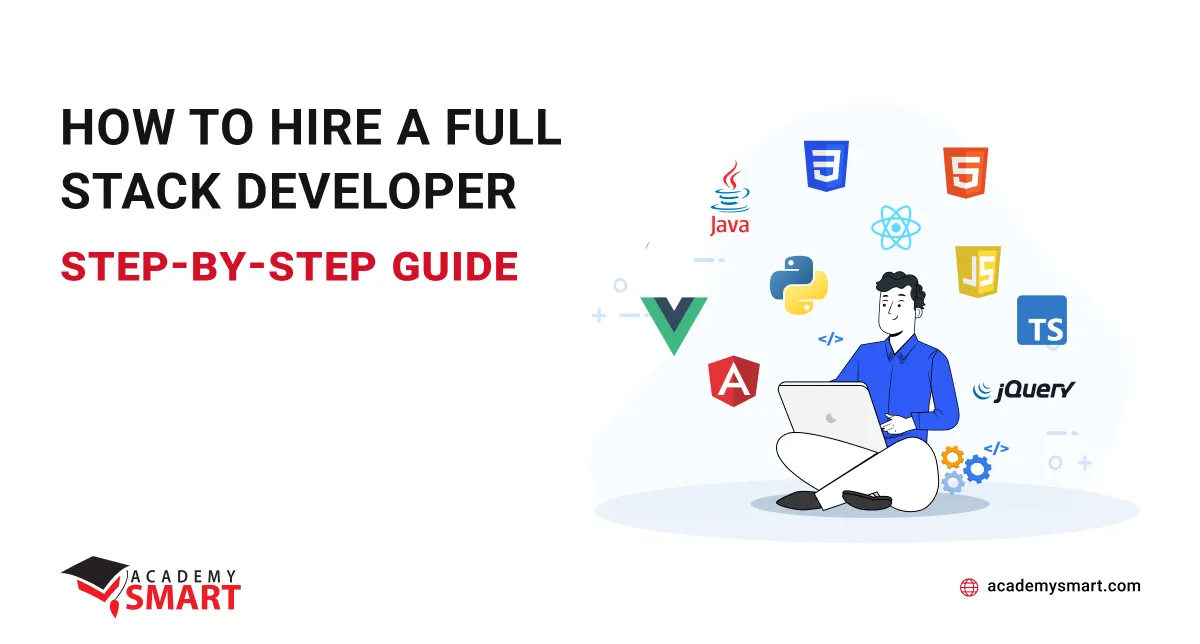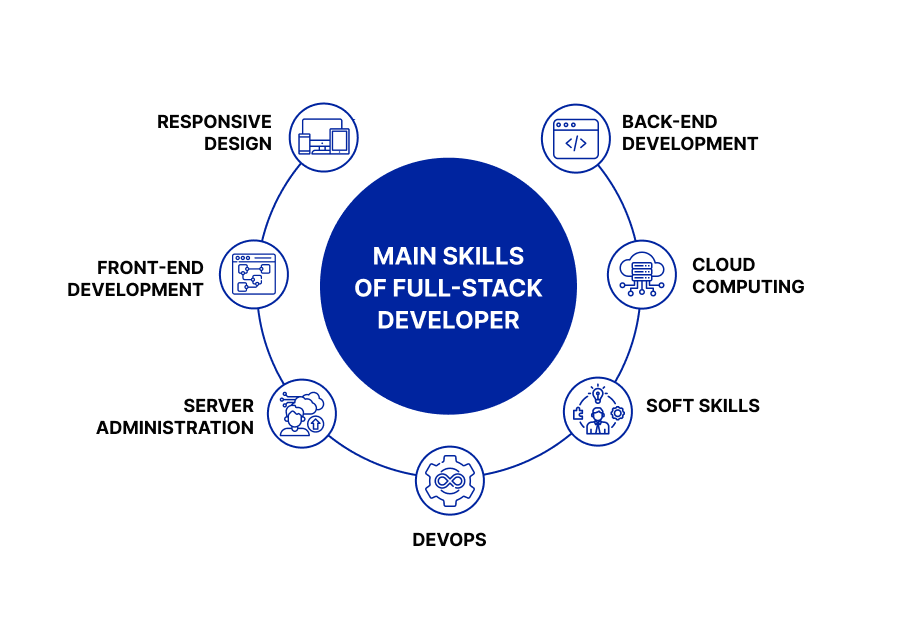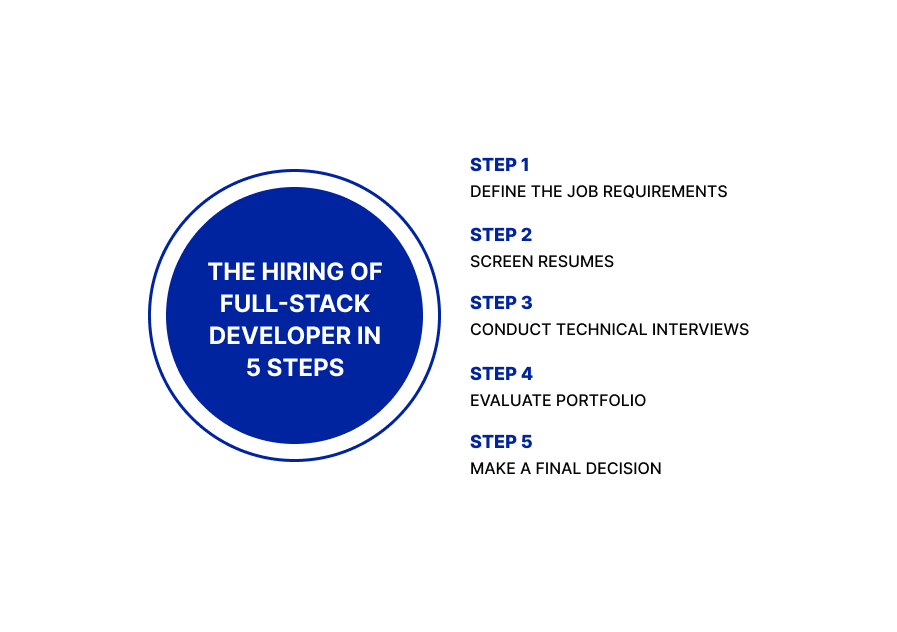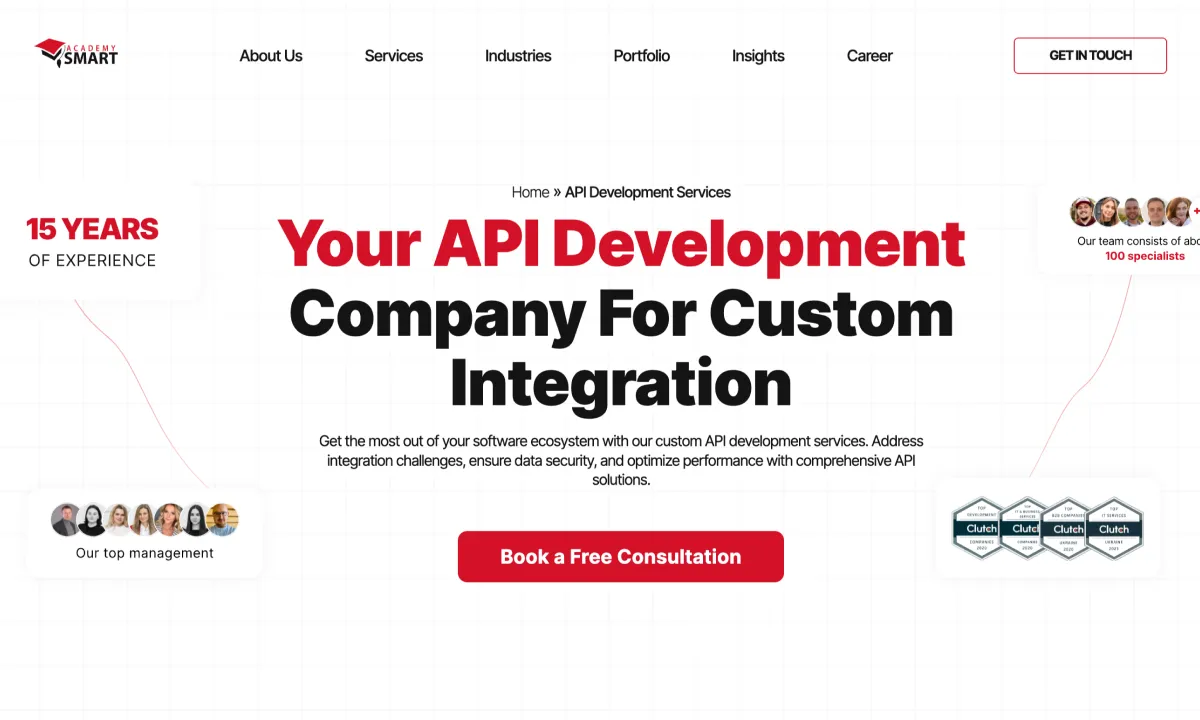
How to hire a Full-Stack developer: step-by-step guide
Contents
Hiring a full-stack developer can be complex, especially in today’s fast-paced and constantly evolving technology landscape. As a business manager, you know that finding the right candidate to handle the entire software development process, from front-end to back-end, is a responsible decision. To ensure success, it’s important to clearly understand the job requirements, evaluate candidates thoroughly, and make an informed hiring decision. Following a structured process, you can meet the right full-stack developer to help drive your company’s growth and success.
What is a Full-Stack developer
A full-stack developer is a highly skilled software engineer proficient in all stages of web development, from front-end user interface design to back-end server-side programming, which you may hire. They broadly understand various technologies, including HTML, CSS, JavaScript, databases, server-side languages, and frameworks (such as Python, Node.js, Java, PHP, etc.). A full-stack coder can develop and deploy complete web applications and play an essential role in creating a company’s digital presence. To learn more about the significance of full-stack developers and other in-demand and high-paying IT jobs, we invite you to check out our blog and explore the latest industry trends and insights.
Why hire Full-Stack developers
Companies that invest in hiring full-stack developers are well-positioned to achieve their business goals and stay ahead of the competition. These highly skilled IT professionals bring a unique combination of technical expertise and business acumen, and they play a critical role in ensuring the success of any web development project. Additionally, full-stack developers are often able to see the bigger picture and better understand how all the pieces of a project fit together, making them better equipped to solve complex problems and identify potential issues before they arise. As a result, they can be more effective and efficient than having several simple programmers working on separate parts of the project.
The task of a full-stack developer is to create, maintain, and test scalable, secure, and easy-to-use software systems. They work on various projects, from small-scale website designs to large-scale e-commerce platforms and enterprise-level applications.
Full-stack developers are valued for their comprehensive understanding of front-end and back-end technologies. It allows them to quickly develop and maintain complex web applications, from the user interface to the database. That’s why full-stack devs are beneficial in projects where a streamlined and efficient workflow is critical.
They can handle the entire development process from start to finish, eliminating the need for multiple specialists and helping ensure deadlines are met. Additionally, full-stack developers often have a broad skill set, which makes them well-suited to oversee and manage other developers on a project. Identifying potential problems or areas for improvement is essential in coordinating development efforts and ensuring a cohesive final product. Their knowledge and experience can serve as valuable resources for the entire development team, making them natural leaders. Here you can get acquainted with the software examples that the full-stack developers of the Smart Academy created.
Skills for a Full-Stack Developer
When hiring a full-stack developer, we’re seeking specific skills to elevate the software capabilities to the next level. A top-notch full-stack dev should bring technical prowess and the ability to seamlessly integrate with your team and get your software vision to life. To fully realize the advantages of having a full-stack coder on your team, we must know what a dev’s skill set and experience of technologies we need.
1. Front-end development
This part of the job includes proficiency in HTML, CSS, and JavaScript and popular front-end frameworks such as Angular, React, and Vue.js. A full-stack developer should be able to create dynamic and responsive user interfaces and be familiar with design principles and UX/UI best practices.
2. Responsive design
As more users access the web on mobile devices, full-stack developers must understand how to create responsive designs that adapt to different screen sizes and resolutions. They should be familiar with CSS frameworks such as Bootstrap, Foundation, and Materialize and have experience with cross-device testing and debugging.
3. Back-end development
It involves knowledge of server-side languages such as PHP, Python, Java, and JavaScript, as well as databases such as MySQL, MongoDB, and PostgreSQL. Full-stack developers should strongly understand RESTful APIs, data modeling, and database integration. A full-stack developer ensures software security through various techniques, including implementing proper authentication and authorization protocols, regular software updates, and utilizing safe coding practices.
Full-stack devs should be familiar with common back-end frameworks such as Node.js, Express.js, Laravel, Django, etc. These frameworks help developers to build scalable, maintainable, and high-performance apps efficiently. Understanding server-side architecture, scalability concepts, and experience integrating third-party services and APIs are essential. Full-stack developers should also be familiar with version control systems such as Git and be able to deploy and manage applications in various environments, including on-premise, cloud, and hybrid.
4. Server administration
Full-stack developers should have a solid understanding of server administration, including security, performance tuning, and troubleshooting. They should be familiar with popular operating systems such as Linux and Windows and have experience with tools such as Apache, Nginx, and IIS. They should be able to configure and manage web servers and deploy and manage applications on these servers.
Usually, full-stack devs monitor server performance and take proactive measures to ensure optimal uptime and functionality. They should be familiar with load balancing and be able to design and implement scalable infrastructure solutions. Full-stack developers must know network protocols, including HTTP, DNS, and TCP/IP, and be able to configure firewall rules and SSL certificates. With server management skills, full-stack developers can ensure web-based applications’ seamless and secure operation.
5. Cloud computing
With more and more companies moving to the cloud, full-stack developers need to have experience with cloud platforms such as AWS, Google Cloud, and Microsoft Azure. They should be able to develop, deploy, and manage applications on these platforms and be familiar with cloud security best practices. Full-stack devs need to know cloud-based technologies and architectures such as Infrastructure as a Service (IaaS), Platform as a Service (PaaS), and Software as a Service (SaaS) to understand the client’s requirements and create a solution that integrates with their existing cloud environment. They should also have experience with containerization and container orchestration technologies such as Docker and Kubernetes to help manage the deployment and scaling of applications in the cloud. Furthermore, knowledge of cloud migration strategies, disaster recovery, and business continuity planning is also essential in today’s cloud computing landscape.
6. DevOps
Full-stack developers should know continuous integration, continuous delivery, and continuous deployment processes, as well as experience with tools such as Docker, Ansible, and Jenkins. They should be able to automate deployment and testing processes and understand how to scale applications to meet the demands of a growing user base.
7. Soft skills
Full-stack developers need a variety of soft skills to be successful as coders and as team leaders. Strong communication skills are essential to convey technical information to technical and non-technical stakeholders effectively. Additionally, they need to be problem-solvers and critical thinkers, able to analyze complex systems and find innovative solutions to challenging issues. They must also have strong collaboration skills, allowing them to work effectively with team members. Time-management skills are also critical, as full-stack developers often manage multiple projects and priorities simultaneously. Finally, they must be adaptable, comfortable with change and continuously learning, and be able to take ownership of their work and take the initiative to drive projects forward.

The main full-stack developer’s skill set
How to find a Full-Stack developer
Recruiting a full-stack coder can be a challenging process, as it requires locating an individual with a strong understanding of both front-end and back-end development. Companies have various options for how to hire a full-stack developer, including in-house recruitment, outsourcing, or using staff augmentation services. They may utilize job boards, professional networking sites, and online freelance marketplaces. Another possibility is to attend local tech events or meetups to network with potential candidates. Additionally, businesses can search for full-stack devs within their networks or seek referrals from contacts for recommendations.
For a streamlined and successful hiring process, it’s wise to turn to professional IT recruiters. These experts can simplify the search process and provide access to a broad pool of qualified candidates. By working with IT agencies, clients can identify the ideal full-stack developer for their specific needs and objectives.
Freelance
When hiring a freelance full-stack developer, businesses often turn to them for temporary projects, such as new feature implementation, bug fixing, software updates, and maintenance. While the engagement may start as a quick solution, the freelancer can become a long-term remote collaborator for the company.
Customers may search for talent through specialized freelance platforms like Upwork or professional social networks like LinkedIn. These platforms provide a secure way for clients and contractors to connect, negotiate, and make payments only after the client approves the work.
Outsourcing
Outsourcing full-stack software development can be cost-effective for companies looking to build their software applications. With fully staffed and qualified personnel, outsourcing eliminates the need for a business to handle the routine recruitment of specialists.
The turnkey approach to software development offered by outsourcing companies is a main advantage. These companies work according to the customer’s vision of the product and provide the necessary resources and specialists. Furthermore, the customer is not burdened with the salary and tax responsibilities of the developers involved in the project. Payment for the entire project is made according to the outsourcing services contract.
Outsourcing companies have a solid online presence, with websites showcasing their portfolios, social media accounts, and listings on reputable rating portals such as Clutch.co.
Outstaffing
Companies specializing in software development often offer a specific service called staff augmentation, allowing customers to hire full-stack developers for their projects. This cooperation model provides the client with the necessary technical expertise quickly and efficiently, without the hassle of searching and recruiting individual software developers.
The outstaffing service allows for flexible participation from the developer, including partial or full-time engagement, and the option to replace remote workers if they do not align with the team’s needs.
When selecting a service provider, it is important to choose carefully, as the IT outstaffing market is highly competitive. Offshore software development services are more cost-effective. You can verify this by reading the materials of the article How to Hire an Offshore Development Team. You may get acquainted with the portfolio of our team on the page below.
Visit our portfolio page for more information
How to hire a Full-Stack developer: 5 steps
Hiring a full-stack dev can be hard, but following this 5-step algorithm can increase your chances of finding the right candidate. These steps include defining job requirements, screening resumes, conducting technical interviews, evaluating portfolios, and making a final decision. With the right approach, you can find a programming engineer to help you achieve your business goals. The key is to know how to hire a full-stack developer effectively.
Step 1. Define the Job Requirements
When hiring a full-stack developer, the first step is defining the job requirements. It is crucial to create a detailed and specific job description that outlines the roles’ responsibilities, tasks, and expectations. Providing clear and specific requirements also ensures that the applicants understand the scope of the job and can determine if they are a good fit for the position. A general or vague job description may not attract the attention of experienced and qualified full-stack devs, as they are more likely to respond to opportunities with clear and well-defined job specifications.
Step 2. Screen Resumes
After you have received some resumes, it’s time to screen them to see if the candidates have the necessary skills and experience to fulfill the job requirements. The key information checklist may include the following:
- technical skills and expertise with Full-Stack development, including specific programming languages and frameworks;
- previous work experience, including the size and complexity of projects, worked on;
- relevant education and certifications;
- problem-solving and critical-thinking abilities;
- communication and collaboration skills;
- ability to work independently or as part of a team.
By verifying these items, you can narrow down the pool of applicants and identify the best fit for the position.
Step 3. Conduct Technical Interviews
Arrange technical interviews with the most promising candidates to gauge their technical knowledge level and ability to apply their skills to solve real-world problems. There are various technical screening methods that you can use, such as coding tests, whiteboard challenges, and hands-on coding assignments.
If you have no technical background, having professional assistance with this step may be helpful. It could be a technical recruiter or a technical advisor from your company. They can help you evaluate the candidate’s technical abilities and ensure that you make an informed decision.
Step 4. Evaluate Portfolio
Ask the candidates to present their previous work and projects. It allows you to see the types of projects the candidate has worked on and the challenges they have faced. It will help you assess their technical skills and how well they work in a team environment. It’s a good idea to ask the candidate to discuss specific cases and challenges from their portfolio and how they approached them. It can give you a deeper understanding of their skills and experience.
Additionally, it’s a verified practice to reach out to the dev’s previous clients or employers to get additional information about their work and performance. It can provide valuable insights into the candidate’s strengths, weaknesses, and overall fit.
Step 5. Make a Final Decision
Based on the results of interviews and portfolio evaluations, decide which candidate to hire. Offer them the job and discuss salary and benefits.
In the final step of hiring a full-stack developer, it is crucial to make an informed decision. So, if you need help finding the right candidate, get it from professional IT recruitment companies. They can provide valuable guidance and support throughout the hiring process, ensuring you make the best decision for your business. They can offer access to a wider pool of talented developers and help you assess their skills, experience, and qualifications more efficiently. It can save you time and effort in the long run and help you find the suitable full-stack dev for your project.

The five common steps to hire full-stack developer
How Academy SMART can help you hire a Full-Stack developer
Academy Smart, as a professional outstaffing agency, can assist with hiring a full-stack developer by providing access to a large pool of talented and experienced programmers. It allows you to save time and resources and ensure a smooth and efficient recruitment.
We handle the recruitment process, from screening resumes to conducting technical interviews to ensure you find the best candidate for the job. And, of course, we manage all HR and administrative tasks, freeing our customers’ time and resources to focus on their core business.
Benefits of Partnering with Academy Smart:
- Professional advice based on in-depth technical analysis of customer needs and market niche software requirements.
- Flexible cooperation models, including dedicated teams, subcontracting, or staff augmentation.
- High qualifications and efficiency of the project development team.
- Extensive use of robust and modern technologies for software development.
- A responsible attitude to our duties and a creative approach to problem-solving.
We are a seasoned custom software development company with over 13 years of experience in the industry. Our highly skilled developers have solid knowledge of the most in-demand technology stacks and have successfully delivered over 100 exceptional projects. Feel free to communicate with us to elevate your software solutions.
Hire Full-Stack developers: Frequently Asked Questions
How much does a Full-Stack developer cost?
The price of a full-stack developer service can vary depending on factors such as their level of expertise, stack specificity, the model of collaboration, and the location. On average, the cost of hiring a full-stack dev at Academy Smart is about 60 euro per hour.
How do I recruit a Full-Stack developer?
To recruit a full-stack developer, you must clearly define the job requirements, screen resumes, conduct technical interviews, and evaluate portfolios. You can also seek help from professional IT recruitment companies if needed.
Book a free consultation

Reach out to start talking today!












